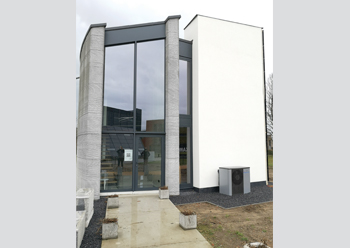Dar Al Arkan launches 3DCP in kingdom
01 September 2021
Dar Al Arkan Properties, in an exclusive partnership with Construction of Buildings on Demand (Cobod), has introduced 3D Construction Printing (3DCP) technology in Saudi Arabia for use on its projects as well as those of others in the kingdom.
Elaborating on the reason behind this collaboration, Ziad El Chaar, Chairman of Dar Al-Arkan Properties, tells Gulf Construction: “Cobod specialises in construction industry innovations. It was very important for Cobod to team up with a well-established Saudi partner like Dar Al Arkan to deploy its technology. The 3DCP technology will accelerate the speed of construction while enhancing safety and reducing wastage and errors.”
The first of the printers procured under this partnership will be used on the property developer’s Shams Ar Riyadh project.
“We are targeting 200 units per year with the first sample to be ready by June 2022,” El Chaar says.
 |
|
3DCP cuts the construction time by more than half, according to El Chaar. |
Located in Riyadh and spanning more than 5 million sq m, Shams Ar Riyadh is a premium masterplan being developed by Dar Al Arkan. The project comprises both commercial and premium residential spaces, incorporated with the finest facilities for an exclusive lifestyle.
Currently seven on-site contractors are executing the project, and the first phase will be handed over this month. The sizes of the houses being built range between 250 and 450 sq m. Dar Al Arkan will use the BOD2 3D construction printer capable of building a three-storey large-scale residential unit. Printers start at €180,000 ($211,400) for the smallest model and can cost more than €1 million for a printer capable of constructing a building with an area exceeding 1,000 sq m on multiple floors, he says.
Commenting on the materials used for printing, he says: “Most materials are locally sourced, the key is the mixing formula for CEM2 cement, sand (fine sand up to 2 mm in size), gravel (2-8 mm in size) and water. These components are mixed to achieve a slump flow of mixed concrete within 400-500 mm before applying stiffener at the nozzle of the 3D printer.”
3DCP is based on the gantry system, which consists of an agile large-scale frame structure that supports the printhead, along an X/Y axis. The printhead can move in various directions to lay a special strong and sustainable concrete formula in a specific pattern based on a predetermined digital design of a home or a building directly on site.
The 3DCP extrudes concrete layer by layer across three dimensions until the whole frame structure is complete without formwork or any subsequent vibration.
“The load-bearing structure of printed 3D walls are designed having a compression strength of a minimum of 30 Mpa. The walls reach a strength of 60 to 70 per cent of its optimal strength within seven days. Curing time as well as the nature of the cement mix and other additives along with the surrounding environment play a pivotal role in achieving the optimum strength of the structure,” he adds.
Citing some of the advantages of the technology, El Chaar says 3DCP cuts the construction time by more than half and is more flexible in design, requires less manpower since a crew of three workers can build one house. This, in turn, creates a safer workplace with decreased manpower downtime and improved on-site safety.
“Additionally, less concrete is needed to complete a building, making the technology more sustainable and a viable solution for the future low-carbon construction industry. For consumers, the combination of these advantages ensures lower costs and more affordability compared to traditional construction.
“The new technology also provides insulation, thus reducing electricity bills. A combination of reduced waste of construction materials, less need for repair or rework and low on-site LTI incidents will enable highly cost-efficient project management than traditional construction,” he points out.
El Chaar emphasises that the new 3DCP technology is being offered in the kingdom to enhance the construction industry locally and deliver on Saudi Vision 2030 at many levels.
“The printer takes two days to set up, only one day to dismantle. It can print up to one metre of concrete in just one second, making it ideal for building residential communities in record time. This will raise the industry standards, achieve excellence and position the kingdom as a leader in this sector, while making us highly competitive in 3DCP technology.
“Also, the 3DCP increases the accuracy of construction, thus there will be fewer repairs and rework, helping save long-term costs,” he points out.
According to El Chaar, Saudi Arabia represents the largest potential market in the Middle East for 3D construction technology, and many high-end customers in the kingdom have been eagerly awaiting the new technology. “The technology will revolutionise how customers buy their homes in the near future, and very soon, our customers will be able to select from various digital building designs and authorise the printing of their homes with a click of a button,” he concludes.
- 3D printing set to transform sites
- Dar Al Arkan launches 3DCP in kingdom
- UHPC demonstrates exciting prospects
- Covid-19 and the rise of digital engineering
- Cifa unveils ‘five-arm’ pump
- Paschal shows forte on Dubai Hills villas



